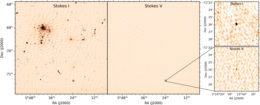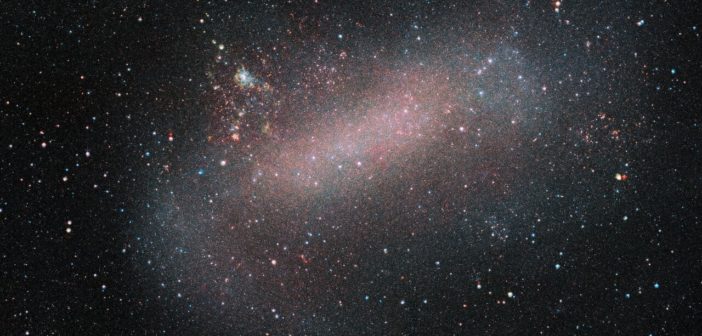Editor’s Note: In these last two weeks of 2022, we’ll be looking at a few selections that we haven’t yet discussed on AAS Nova from among the most-downloaded articles published in AAS journals this year. The usual posting schedule will resume in January.
Discovery of PSR J0523-7125 as a Circularly Polarized Variable Radio Source in the Large Magellanic Cloud
Published May 2022

Total intensity (left) and circularly polarized intensity (right) images of part of the Large Magellanic Cloud at 888 megahertz, as seen by ASKAP. The zoomed-in images show the location of the newly discovered pulsar. Click to enlarge. [Wang et al. 2022]
Main takeaway:
A team led by Yuanming Wang (The University of Sydney, Australia) reported the discovery of a pulsar — the dense, rapidly spinning remnant of a massive star’s core — using radio continuum data from the Australian Square Kilometre Array Pathfinder (ASKAP). The newfound pulsar is located in the Large Magellanic Cloud, a satellite galaxy of the Milky Way, and its discovery may pave the way for astronomers to find other extragalactic pulsars with unusual properties.
Why it’s interesting:
The newly discovered pulsar, PSR J0523−7125, is one of the most luminous known radio pulsars, but several aspects of its radio signal made it difficult to find: while most pulsars are identified via their brief flashes of radio emission, PSR J0523−7125’s pulses are uncharacteristically broad, and its radio emission falls off sharply at higher frequencies. Wang and collaborators observed the new pulsar as part of the Variables and Slow Transients (VAST) survey and identified it based on its high degree of circular polarization and lack of a multiwavelength counterpart.
Prospects for finding further pulsars:
This work by Wang and collaborators shows that radio surveys are a viable means of discovering pulsars with unusual pulse properties. The combination of circular polarization data with multiwavelength images is especially useful, allowing researchers to identify sources that emit circularly polarized light but are absent in optical images. The authors also posit that future searches with the Next Generation Very Large Array — a network of 263 radio dishes scheduled to begin construction in 2026 — could lead to the first discovery of a pulsar in another neighboring galaxy, Andromeda.
Citation
Yuanming Wang et al 2022 ApJ 930 38. doi:10.3847/1538-4357/ac61dc

